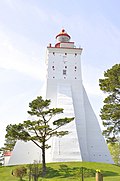Keri Lighthouse
Keri lighthouse (Estonian: Keri tuletorn) is a lighthouse in Estonia, located on the Keri (Kockskär) island in the Gulf of Finland of the Baltic Sea. The light is at an elevation of 31 metres (102 ft) above sea level, while the lighthouse is 28 metres (92 ft) tall.
History
The present-day lighthouse was built in 1858. It is a red metal cylinder topped with the lantern room and balcony which rests upon a cylindrical stone base. This light is computer controlled, powered by solar cells and batteries.
The original wooden lighthouse was built in 1724. It was rebuilt in the early 19th century with a stone base topped with a wooden tower.
From 1907 to 1912 it was the only lighthouse in the world to be powered by natural gas. In 1990 the stone base began to collapse and steel reinforcements were installed. In 2007 an internet camera was installed followed by an internet weather station in 2009.
Specifications
During hours of darkness the light cycles with the following sequence: 13 seconds off; 2 seconds on. The light can be seen from 11 nautical miles.
Postage stamp
The Estonian Post Office issued a stamp commemorating the Keri Lighthouse on 15 January 2003. First day cancel covers were also issued on that day.
Gallery
-
Keri Lighthouse in 2005
-
Keri Lighthouse and surrounding buildings, 2008
-
Sauna, memorial monument to the Kaleva, and the lighthouse
-
Interior
-
Stair
-
Light
See also
References
- ^ "Maritime Administration, Keri Lighthouse (in Estonian)". Archived from the original on 1 February 2014. Retrieved 27 April 2012.
- ^ Rowlett, Russ. "Lighthouses of Northern Estonia". The Lighthouse Directory. University of North Carolina at Chapel Hill. Retrieved 7 May 2019.
- ^ Keri Lighthouse Archived 23 November 2015 at the Wayback Machine Estonian Lighthouse Society
External links
- Kinnismälestis, Arhitektuurimälestis nr 9500 Kultuurimälestiste riiklikus registris
- Keri lighthouse photo 2005
- "Navigatsioonimärgi 155, Keri tuletorn andmed". Navigatsioonimärkide andmekogu (in Estonian). 17 January 2018. Archived from the original on 17 January 2018. Retrieved 7 May 2019.






